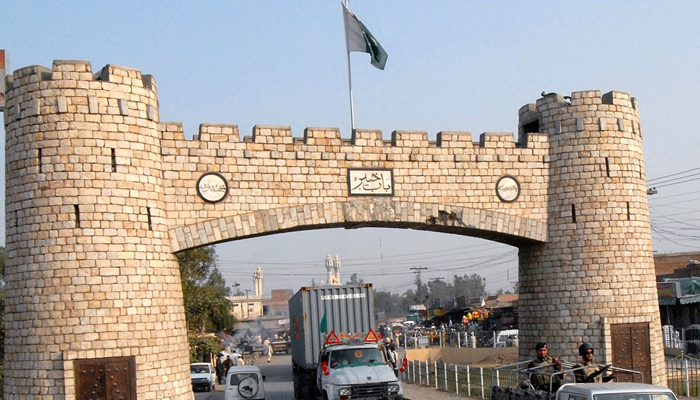Peshawar’s ancient wells: the past ripples beneath the surface
PESHAWAR: Beneath the blazing Peshawar sun, there was a time when the city’s very heartbeat pulsed through its cool water wells. The memory of those times still lingers, though the wells themselves have long been consigned to history.
Peshawar, a city with a rich tapestry of history, still holds a few of these ancient wells in its embrace. They may no longer quench the thirst of the city as they once did, but their presence whispers stories of a bygone era when the people of Peshawar would gather from far and wide to fetch the refreshing nectar of these deep wells. In a world before the convenience of tube-wells, these sacred pools were the lifeblood of the city’s denizens.
Imagine strolling through the old walled city of Peshawar, and you might stumble upon the Sard Chah Gate, known as the Cool Well Gate. In the heart of this historical gate once lay an ancient well, now dry and barren. Local folklore tells us that this well has witnessed more than a century of Peshawar’s history, so cherished that the very area around it bears its name.
Then there is Kala Kuie, the Well of Kala. Kala, a Mashki or water bearer, was a figure of utmost importance in this land. With his trusty Mashk, a traditional water-carrying bag fashioned from waterproofed goat-skin, he would not only sprinkle water on the dusty streets but also provide a lifeline to the local residents. Kala Kuie’s story dates back over two centuries, a testament to the city’s resilience and innovation in finding sources of life-giving water.
The role of the Mashki was vital. Long before the dawn of water-sprinkling vehicles, these municipal employees would commence their morning ritual, laying the groundwork for the city’s cleanliness. They’d settle the dust on the streets with their early-morning watering, ensuring that when the sweepers arrived, there would be far less dust to contend with. Kala Kuie’s waters were famed for their coolness, attracting not just the locals but visitors from across the city.
In the heart of Wazirbagh, a Mughal-era garden established in 1908 during the reign of Wazir Fateh as governor of Peshawar, another ancient well stands. It, too, is said to be over a century old, and its presence is a nod to the city’s past. And not to be forgotten, there’s a well nestled within the Gor Gutri archaeological complex, where layers of history intertwine with the deepest roots of Peshawar’s soul.
Ibrahim Zia, a historian who authored a book titled “Peshawar, Tareekh ke Dareechon Mein”, reveals a world where the past flows like water from these ancient wells. The story of Peshawar is etched in the cool depths of these wells, a city that has always known how to treasure its history.
“More than a century ago, water from the Bara region used to be filtered for Peshawar region residents. However, people used to drink from the wells in summers. I remember that in Ramazan, people would just mix sharbat in it and there was no need of even ice for this,” Zia told this scribe.
He also said that water from the Bara region was more beneficial for health. “Sometimes chlorine is added to water now. But Bara water was natural and it flowed from mountains. I suggest the filtration of Bara water should be resumed, given the falling water table in the ongoing circumstance,” he added.
-
 Sarah Ferguson Updates Her Plans Now That Andrew’s Eviction Is Nine Days Away
Sarah Ferguson Updates Her Plans Now That Andrew’s Eviction Is Nine Days Away -
 Hailey Bieber Sends Cease And Desist To TikToker
Hailey Bieber Sends Cease And Desist To TikToker -
 Kate Middleton Celebrates England Women's Rugby Stars After World Cup Win
Kate Middleton Celebrates England Women's Rugby Stars After World Cup Win -
 Kris Jenner Dubs Chicago West Her 'sweet Angel' As She Turns Eight
Kris Jenner Dubs Chicago West Her 'sweet Angel' As She Turns Eight -
 Josh Charles Credits Taylor Swift For His, Ethan Hawke’s Moon Person Trophies
Josh Charles Credits Taylor Swift For His, Ethan Hawke’s Moon Person Trophies -
 Jodie Foster Voices Opinion About 'misogyny'
Jodie Foster Voices Opinion About 'misogyny' -
 Virginia Madsen Remembers Late Brother Michael Madsen Six Months After His Death
Virginia Madsen Remembers Late Brother Michael Madsen Six Months After His Death -
 Emilia Clarke Reveals Real Price Of Playing Daenerys In 'Game Of Thrones'
Emilia Clarke Reveals Real Price Of Playing Daenerys In 'Game Of Thrones' -
 Ex-Chicago Mayor Hit With Lawsuit Over Unpaid Credit Card Bills
Ex-Chicago Mayor Hit With Lawsuit Over Unpaid Credit Card Bills -
 Andrew Risks His Relationships With Princess: ‘She’s Supporting The Abused And It’s Festering’
Andrew Risks His Relationships With Princess: ‘She’s Supporting The Abused And It’s Festering’ -
 Harry Styles Unveils New Album After Cryptic Posters Spark Fan Frenzy
Harry Styles Unveils New Album After Cryptic Posters Spark Fan Frenzy -
 Prince Harry Ready To Return To The UK To King Charles But It’ll Depend On How THIS Goes
Prince Harry Ready To Return To The UK To King Charles But It’ll Depend On How THIS Goes -
 Why Isn't King Charles Mourning Death Of His Father's First Cousin?
Why Isn't King Charles Mourning Death Of His Father's First Cousin? -
 Nicole Richie Breaks Silence On Her Daughter's Name Change
Nicole Richie Breaks Silence On Her Daughter's Name Change -
 Truth Behind Chris Noth, Sarah Jessica Parker's Ongoing Feud Revealed
Truth Behind Chris Noth, Sarah Jessica Parker's Ongoing Feud Revealed -
 Baseless Gender Identity Rumors Targeted At Bettijo Hirschi After Todd Bridges Split
Baseless Gender Identity Rumors Targeted At Bettijo Hirschi After Todd Bridges Split




